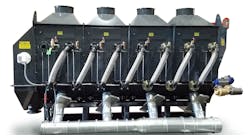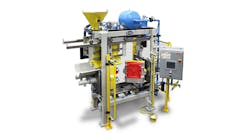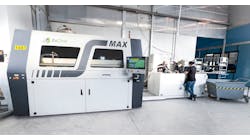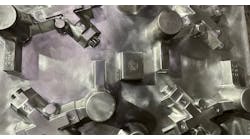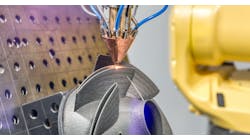Today’s metalcasting operations rely on up-to-date systems and advanced technologies being deployed to produce a range of durable goods essential to modern life — from appliances to aircraft carriers. Still, many U.S. foundries’ vintage sand-handling systems need upgrading to meet the increasing complexities and quality requirements of the products produced, as well as to maintain the higher levels of productivity necessary to be competitive by global standards. In its “2020 Forecast & Trends” report, the American Foundry Society anticipates a 1.6-1.8% growth rate this year and 2.2% annually through to 2028, as the U.S. cements its position as a top-three producer of metalcastings, following China and India.
However, according to AFS’ most recent member survey, nearly one-third of foundries identify equipment as a barrier to capacity growth. New production equipment is their top priority for capital investments, followed by environmental controls and expansion.
At the same time, foundries are continually challenged to drive down energy and maintenance costs (in the AFS member survey, more than 80% of respondents noted their energy costs are rising), as well as to address increasingly stringent emission controls.
Meanwhile, since 2018 the U.S. Occupational Safety and Health Administration has been enforcing its new crystalline silica regulation, with the permissible exposure limit (PEL) for airborne silica reduced to half the previous standard, from 100 µg (micrograms)/cu.m to 50 µg/cu.m. Of course, U.S. foundries use millions of tons of silica sand each year in the production of critical metalcastings.
“Add this to the existing challenge of accurately controlling chemical no-bake and core foundry sand temperatures, and many operators are telling us that this is adding up to a perfect storm for them,” said Scott Harris, Regional Director, Americas for Solex Thermal Science, a North American expert in bulk-solids thermal exchange.
Taking a new direction — Advances in heat-transfer technology are giving foundries an opportunity to reset their prospects versus these regulatory, technological, and competitive pressures. “While traditionally served by direct-contact solutions such as fluid beds, indirect plate exchangers provide the ability during core sand-conditioning to handle more product in less space, while using less energy, emitting near-zero emissions, and providing highly accurate temperature control,” according to Harris.
Simple in design yet sophisticated in its results, the technology pioneered by Solex uses vertically oriented pillow plates with internal channels through which flows a fluid, counter-currently, to indirectly heat or cool a variety of bulk solids, including foundry sand.
The sand particles move by gravity between the plates, while a mass-flow discharge device – typically a vibratory or cone feeder for sand applications – guarantees the uniform flow of the product through the exchanger, thereby producing at discharge a product with uniform temperature.
“At the heart of the Solex technology lies a thermal modelling software that we’ve developed to calculate product temperature profiles at every point through the heat exchanger, to accurately predict performance,” Harris said.
Design and process benefits — Gerald Marinitsch, Global Director, Industrials, with Solex noted the modular design and vertical orientation of today’s plate heat-exchangers make them an ideal choice for debottlenecking or revamping plant operations.
“Basically, you can quickly and easily increase capacity without sacrificing additional floor space,” he said, noting the average unit measures three feet by three feet.
“This provides the dual benefit of being able to retrofit existing plants with minimal CapEx and infrastructure modifications, while also handling much higher through-puts because of the ability for plates to offer more heat transfer area than the equipment being used today,” Marinitsch added.
Meanwhile, the current use of fluid beds for sand temperature control introduces direct contact between the air and the sand product. This highly energetic, blowing air results in silica dust being emitted from the process. In addition to the need for additional equipment required to clean the air, this also contributes to employee exposure to respirable crystalline silica, and the potential for the various serious illnesses that, according to OSHA, may result from exposure to airborne silica.
With indirect heat-exchange technology, the sand product does not come into direct contact with air during heat transfer, thereby reducing workers’ risk of exposure.
As air is not used in the heating or cooling process, the heat exchangers also do not need blowers, ducting, and associated air-handling and -cleaning equipment.
“It is a simple and robust solution for core-sand conditioning,” Marinitsch added. “And as a result, we’ve found that indirect heat exchangers use up to 90% less energy when compared with traditional technologies such as fluid beds.”
Temperature control — For metalcasting operations, it is critical to maintain a consistent AFS Grain Fineness Number (AFS-GFN), which measures sand-grain fineness as a proportion of the number of grains per unit of weight and the specific surface area of the sand.
To maintain such consistency, great care needs to be taken in the design of equipment to prevent and eliminate sand segregation, Harris noted. Fluidized beds can and often do change the AFS GFN of the sand before going to mold.
In addition, batch processing and intermittent shutdowns can further challenge foundries’ ability to provide accurate control of sand temperature, which can lead to expensive inefficiencies such as productivity losses, core scrap, and casting scrap and rework.
“Indirect plate heat-exchange technology acts as a temperature-controlled, sand-conditioning system that can deliver accurate and consistent temperatures within 1°F,” Harris said, noting temperatures in current technologies often vary by up to 20°F.
To keep temperatures consistent, Harris recommends introducing a closed-loop heating/cooling fluid temperature module: In winter months, when the core sand can dip below the ideal process temperature, the module can heat water in a closed loop. Conversely, in the summer when the sand may be too hot for efficient molding and coremaking, then the module is cooling the water.
“Also, it doesn’t matter then if production halts for a night or a weekend; if ambient temperatures are 22°F or 82°F,” Harris said. “The temperature is maintained at all times, even when the sand capacity is intermittent, running continuously or stopped for a long period of time.”
Jamie Zachary is the Marketing & Communications Manager for Solex Thermal Science Inc., Calgary, AB. Contact Solex at [email protected]



